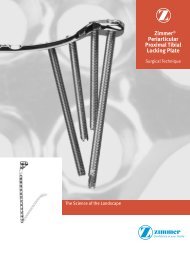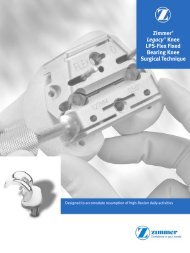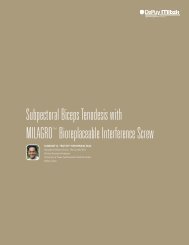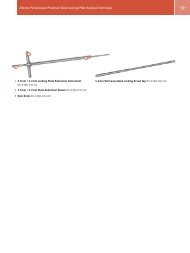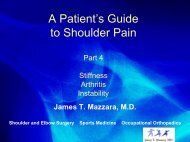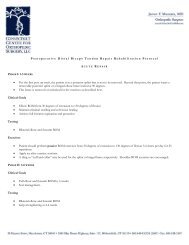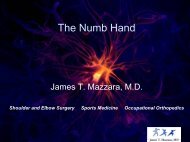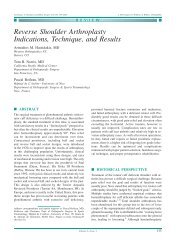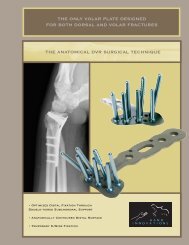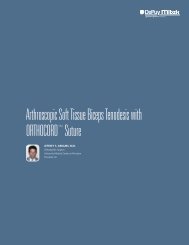SHOULDER ARTHROSCOPY POSTOPERATIVE INSTRUCTIONS ...
SHOULDER ARTHROSCOPY POSTOPERATIVE INSTRUCTIONS ...
SHOULDER ARTHROSCOPY POSTOPERATIVE INSTRUCTIONS ...
Create successful ePaper yourself
Turn your PDF publications into a flip-book with our unique Google optimized e-Paper software.
Patient Name ____________________________________________<br />
Date ___________________________________________________<br />
<strong>SHOULDER</strong> <strong>ARTHROSCOPY</strong> <strong>POSTOPERATIVE</strong> <strong>INSTRUCTIONS</strong><br />
Activity: After your shoulder arthroscopy, you will be placed in a sling or arm immobilizer. Depending on the procedure<br />
performed, you may either use the arm as tolerated when the nerve block wears off or you may need to keep the arm<br />
completely immobilized until you are seen in the office and receive further post-op instructions.<br />
You may do any of the exercises in this program until you are seen in the office.<br />
You may use the arm as tolerated when the block wears off within 24 hours.<br />
Remove the sling at 24 hours and use the arm as tolerated. Start the attached exercises after 48 hours.<br />
Apply ice packs to the shoulder as often as needed. You may apply ice continuously if you wish. Sleep in a reclined position<br />
for comfort. Lying flat can be painful following shoulder surgery.<br />
Dressing: Expect some bloody drainage onto the post op dressing within the first 24 hours. If it is indicated that you can use<br />
the arm and remove the sling, after 24 hours, you can remove the dressing and shower. Cover the small incisions with Band-<br />
Aids after the shower. Its OK to get the arthroscopy incisions wet in a shower after 24 hours but do not soak them in bath<br />
water for one week. The sutures in your skin will dissolve in time. They should be cleaned with alcohol daily and covered with<br />
Band-Aids after the dressing is removed at 24 hours. If there are paper Steri-strips over the wounds, do not remove them.<br />
Medication: You may resume your normal medications that you took prior to surgery. The directions for the use of the pain<br />
medication will be on the prescription. Medication refills will only be done by me or my office during the week from 8am -4pm.<br />
Narcotic pain medications will not be refilled after 4 pm or on the weekends. Plan ahead. Medications for postoperative pain<br />
are as follows:<br />
____________________________________<br />
1-2 pills every 4 hours if you have pain.<br />
You may take 3 tabs of ________________________every 4 hours for very severe pain.<br />
You may take Extra-Strength Tylenol as directed on the label. You may also take over-the-counter anti-inflammatory<br />
medications such as aspirin, Advil or Aleve if you know you can tolerate these medications. Once the nerve block begins to<br />
wear off, start your pain medicine.<br />
Follow up: Call the office to schedule an appointment for approximately ______ days after your surgery.<br />
I will discuss the procedure and the findings at surgery during our first post-op visit.<br />
Problems: While complications from shoulder arthroscopy are uncommon, you must be aware of the early warning symptoms<br />
of some of the more serious problems that may arise. The risk of surgery is never “zero”.<br />
A temperature over 101 degrees. This could be due to inactivity and lung congestion, but may also be signs of infection.<br />
Call the office for numbness, pins and needles, and extreme pain not relieved by the medication provided.<br />
Driving: You may resume when you are no longer taking narcotic pain medications and when you have adequate control of<br />
your shoulder and arm so that you can use the arm with minimal discomfort. This is a matter of your safety and the safety of<br />
those around you on the road.<br />
You can get more information about shoulder arthroscopy and the exercises required after surgery online at<br />
www.OrthoOnTheWeb.com or at www.Orthodoc.aaos.org/jtmazzara under the Shoulder Surgery Exercise Guide.
Shoulder Arthroscopy Postoperative Instructions<br />
Page 2<br />
Regular exercises to restore your normal shoulder motion and flexibility and a gradual return to everyday work and recreational activities are important for your<br />
full recovery. We recommend that you exercise from 10 to 15 minutes 2 or 3 times a day during your early recovery period. They may suggest some of the following<br />
exercises. This guide can help you better understand your exercise and activity program. You should only do these exercises if I have indicated hat<br />
it is OK to move your shoulder on the front page of the brochure. Start them ~48 hours after surgery.<br />
Pendulum, Circular - Bend forward 90 degrees at the waist, using a table for<br />
support. Rock body in a circular pattern to move arm clockwise 10 times, then<br />
counterclockwise 10 times. Do 3 sessions a day.<br />
Shoulder Flexion (Assistive) - Clasp hands together and lift arms above<br />
head.<br />
Can be done lying down (drawing A) or sitting (drawing B). Keep elbows as<br />
straight<br />
as possible. Repeat 10 to 20 times. Do 3 sessions a day.<br />
Supported Shoulder Rotation - Keep elbow in place and<br />
shoulder blades down and together. Slide forearm back and forth.<br />
Repeat 10 times. Do 3 sessions a day.<br />
Walk Up Exercise (Active) - With elbow straight, use fingers to "crawl" up<br />
wall or door frame as far as possible. Hold 10 seconds. Repeat 3 times.<br />
Do 3 sessions a day.
Shoulder Arthroscopy Exercise Guide<br />
Page 3<br />
Shoulder Internal Rotation (Active) - Bring hand behind back and across to opposite side. Repeat 10<br />
times. Do 3 sessions a day.<br />
Shoulder Flexion (Active) - Raise arm to point to ceiling, keeping elbows straight. Hold 10 seconds.<br />
Repeat 3 times. Do 3 sessions a day.<br />
Shoulder Abduction (Active) - Raise arm out to side, elbow straight and palm downward.<br />
Do not shrug shoulder or tilt trunk. Hold 10 seconds. Repeat 3 times. Do 3 sessions a day.<br />
Shoulder Extension (Isometric) - Stand with your back against the wall and your arms straight at<br />
your sides. Keeping your elbows straight, push your arms back into the wall. Hold for 5 seconds,<br />
then relax. Repeat 10 times.<br />
Shoulder External Rotation (Isometric) - Stand with the involved side of your body against a wall.<br />
Bend your elbow 90 degrees. Push your arm into the wall. Hold for 5 seconds, then relax. Repeat 10<br />
times.
Shoulder Arthroscopy Exercise Guide<br />
Shoulder Internal Rotation (Isometric) - Stand at a corner of a wall or in a door frame. Place the<br />
involved arm against the wall around the corner, bending your elbow 90 degrees. Push your arm into the<br />
wall. Hold for 5 seconds, then relax. Repeat 10 times.<br />
Shoulder Internal Rotation - Keep elbow bent at 90 degrees. Holding light weight, raise<br />
hand toward stomach. Slowly return. Repeat 10 times. Do 3 sessions a day.<br />
Shoulder External Rotation - Keep elbow bent at 90 degrees at side. Holding light weight,<br />
raise hand away from stomach. Slowly return. Repeat 10 times. Do 3 sessions a day.<br />
Shoulder Adduction (Isometric) - Press upper arm against a small pillow alongside your body.<br />
Hold 5 seconds. Repeat 10 times. Do 3 sessions a day.<br />
Shoulder Abduction (Isometric) - Resist upward motion to the side, push arm<br />
against back of chair. Hold 5 seconds. Repeat 10 times. Do 3 sessions a day.<br />
Reference: http://orthoinfo.aaos.org/booklet/view_report.cfm?D=19&topcategory=Shoulder



